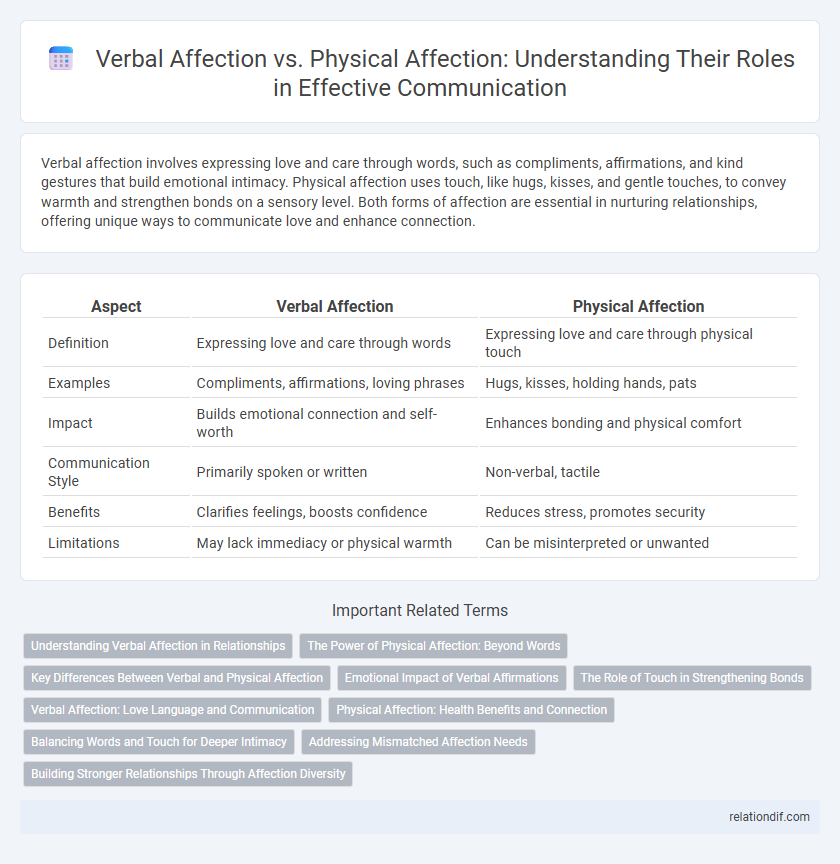Verbal affection involves expressing love and care through words, such as compliments, affirmations, and kind gestures that build emotional intimacy. Physical affection uses touch, like hugs, kisses, and gentle touches, to convey warmth and strengthen bonds on a sensory level. Both forms of affection are essential in nurturing relationships, offering unique ways to communicate love and enhance connection.
Table of Comparison
| Aspect | Verbal Affection | Physical Affection |
|---|---|---|
| Definition | Expressing love and care through words | Expressing love and care through physical touch |
| Examples | Compliments, affirmations, loving phrases | Hugs, kisses, holding hands, pats |
| Impact | Builds emotional connection and self-worth | Enhances bonding and physical comfort |
| Communication Style | Primarily spoken or written | Non-verbal, tactile |
| Benefits | Clarifies feelings, boosts confidence | Reduces stress, promotes security |
| Limitations | May lack immediacy or physical warmth | Can be misinterpreted or unwanted |
Understanding Verbal Affection in Relationships
Verbal affection in relationships involves expressing love, appreciation, and support through spoken or written words, enhancing emotional intimacy and trust. It includes compliments, affirmations, and sincere conversations that validate partners' feelings and strengthen bonds. Understanding verbal affection helps partners communicate needs effectively, fostering a secure and connected relationship environment.
The Power of Physical Affection: Beyond Words
Physical affection, such as hugging, holding hands, and gentle touch, deeply strengthens emotional bonds by releasing oxytocin, the "love hormone," which reduces stress and promotes feelings of security and trust. Unlike verbal affection, physical touch conveys empathy and connection instantly without the need for language, making it a universal form of expressing love and care. Research indicates that couples engaging in regular physical affection report higher relationship satisfaction and emotional intimacy compared to those relying primarily on verbal communication.
Key Differences Between Verbal and Physical Affection
Verbal affection communicates love and care through words, such as compliments, affirmations, and expressions of gratitude, directly engaging the emotional and cognitive processing centers. Physical affection involves tangible, nonverbal interactions like hugs, kisses, and touch, which stimulate oxytocin release and foster a sense of security and bonding. The key difference lies in their modes of expression--verbal affection relies on linguistic communication to convey feelings, while physical affection leverages somatosensory experiences to strengthen relational connections.
Emotional Impact of Verbal Affirmations
Verbal affirmations play a crucial role in fostering emotional intimacy by explicitly expressing love, appreciation, and support, which strengthens trust and connection in relationships. Unlike physical affection, verbal communication allows partners to articulate their feelings clearly, helping to reduce misunderstandings and build a secure emotional foundation. Research indicates that consistent verbal affirmations can enhance psychological well-being, increase feelings of self-worth, and improve overall relationship satisfaction.
The Role of Touch in Strengthening Bonds
Touch acts as a powerful nonverbal form of communication that enhances emotional connections and trust between individuals. Physical affection releases oxytocin, a hormone that fosters bonding and reduces stress, making relationships more resilient. In contrast to verbal affection, which conveys feelings through words, touch provides immediate, tangible reassurance that strengthens interpersonal bonds on a deeper, sensory level.
Verbal Affection: Love Language and Communication
Verbal affection as a love language plays a crucial role in strengthening emotional bonds by expressing love through words, compliments, and affirmations, which enhances clarity and emotional intimacy in communication. Effective verbal communication allows partners to articulate their feelings, reduce misunderstandings, and foster trust, making it an essential component of healthy relationships. Studies in relationship psychology confirm that consistent verbal affection significantly improves relationship satisfaction and emotional connection.
Physical Affection: Health Benefits and Connection
Physical affection, such as hugging, holding hands, and cuddling, releases oxytocin, which reduces stress hormones and promotes emotional bonding. Regular physical touch has been linked to lower blood pressure, improved immune function, and decreased anxiety levels. This tactile connection strengthens relationships by fostering trust, safety, and deeper intimacy between partners.
Balancing Words and Touch for Deeper Intimacy
Balancing verbal affection and physical affection enhances emotional connection and fosters deeper intimacy in relationships. Words of affirmation express love and appreciation, while meaningful touch conveys comfort and security, creating a dynamic interplay that strengthens bonds. Prioritizing both communication styles helps partners feel valued and understood, promoting holistic emotional well-being.
Addressing Mismatched Affection Needs
Addressing mismatched affection needs requires recognizing individual preferences for verbal affection, such as praise and affirmations, versus physical affection, including hugs and touch. Effective communication involves openly discussing these differences to foster understanding and meet each partner's emotional needs. Tailoring affection expressions to align with each person's love language promotes deeper connection and reduces relational tension.
Building Stronger Relationships Through Affection Diversity
Verbal affection, including words of appreciation and encouragement, enhances emotional intimacy by clearly expressing love and support, while physical affection, such as hugs and touch, fosters closeness and reassurance through nonverbal connection. Integrating both verbal and physical affection diversifies communication methods, catering to different emotional needs and strengthening relationship resilience. Studies indicate couples who balance verbal and physical affection experience higher satisfaction and deeper trust, highlighting the importance of affectionate diversity for relationship growth.
Verbal Affection vs Physical Affection Infographic

 relationdif.com
relationdif.com